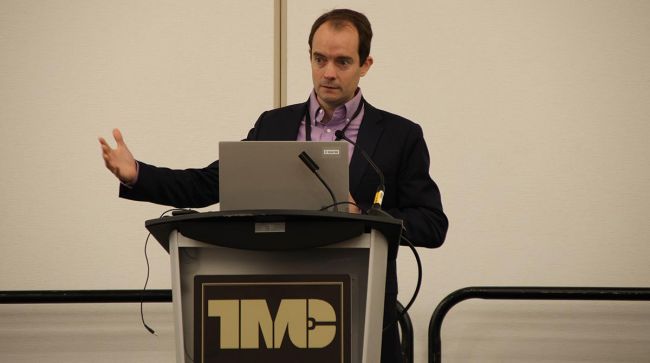Ryan Wheeler says fleet electrification projects tend to be bigger than most utility connections. (Blake Franko, TMC)
Facility electrification timelines for U.S. heavy-duty trucking fleets are likely to be more protracted than carrier executives might expect, according to early movers in the sector and executives at power utilities.
Bureaucracy is likely to take time to work through, especially for infrastructure approval; parts of the electricity industry supply chain are already short key pieces of equipment, a scenario likely to get worse; and the power industry moves at a glacial pace, even compared with the trucking industry, observers warned.
Speaking at American Trucking Associations’ Technology & Maintenance Council’s 2023 Summer Conference & Fleet/Utility Forum June 20-21, National Grid Fleet Electrification Product Owner Ryan Wheeler said the construction timeline envisioned for facilities supporting fleet electrification is much faster than utilities and the state regulators that approve their capital spending have been used to. National Grid supplies 20 million power and natural gas customers in New York and Massachusetts.
While society demands companies decarbonize their operations at an ever faster pace, observers said a lot of work, and especially planning, is required to meet those expectations.
That’s a wrap on #TMCSummer23! Thank you to our attendees, speakers, and event partner @EPRINews for an electrifying event! ⚡️ pic.twitter.com/yxpb2aYKtE
— Technology & Maintenance Council (TMC) of ATA (@TMC4Trucks) June 22, 2023
Among the many tasks, executives must gain a good understanding of how much power they will need, and is available; whether the distribution line needs undergrounding; and where the charging station or stations can be located on their properties, Online Transport Inc. Vice President of Safety & Maintenance Randy Obermayer told forum attendees June 20.
Obermayer, a former TMC chairman, told conference attendees the key to fleet electrification was planning the infrastructure surrounding the shift in advance.
During the same panel, Ryder System Inc. Director of Maintenance Arun Chickmenahalli said facility assessment and installation could take up to 24 months for initial projects — which are a fraction of the size of the facilities set to be built down the line — and that fleet owners applying for grants to make the economics work should factor in an eight-month timeline.
Grants are critical to the success of fleet electrification projects at the moment, especially when it comes to total cost of ownership, said a third member of the panel, US Foods Fleet Sustainability Senior Manager Kenneth Marko.
Applications for grants can take at least six months to process, so that must be factored into the timeline for fleet owners, said Marko, who provided in-depth insight a day later of a pilot electrification scheme in California he managed for US Foods, which ranks No. 2 on Transport Topics’ top food service carriers list.

Marko says grants are critical to the success of fleet electrification. (Blake Franko, TMC)
Marko said fleet owners will need top-notch communications with utility companies based on his experience. It was a message echoed by a senior utility executive.
Fleet owners must contact their local utility early and often, said David Owen, electrification manager at CenterPoint Energy, which provides power and natural gas distribution services to 7 million customers across eight states.
There is plenty to work out. Among the questions that must be asked when planning is underway, said Southern California Edison Senior Project Manager of Transport Electrification John Nelson, are whether upgrades are going to be needed to a fleet owner’s infrastructure down the line, is the charging location upstream or downstream of major loads on the transmission grid and will a substation need building. Southern California Edison serves roughly 15 million customers and is a key partner in California’s nation-leading push for electrification of transportation.
Trucking companies eyeing changes to their facilities must be aware that equipment order timelines in the electricity industry are also much longer than the trucking industry is used to, Volvo Group Trucks Vice President of Product Planning Keith Brandis told the forum June 20. Some components may not be available at all, he said, while others may have a 24-month order requirement.
The key question, said CenterPoint’s Owen, is whether a company has access to the transformer it is going to need. He warned that transformer lead times are being pushed out because of a scarcity of electrical equipment steel.
Orlando Utilities Commission New Products & Services Manager Peter Westlake, meanwhile, warned it may take five years for a substation to be built at especially large facilities.
That timeline indication asks a lot of all parties in the electrification push. “We really liked being in an industry that liked to be slow to change,” SoCal Edison’s Nelson said.
Utilities typically take two to five years to connect major projects, so now they are being asked to complete projects four years quicker than they are used to, Wheeler said. In addition, fleet electrification projects tend to be bigger than most utility connections, with demand greater than that of a National Football League stadium, he said.
Some truck stops will need connecting to 40 megawatts of peak demand, the same consumption as a large town, Wheeler said. Medium- and heavy-duty trucks will account for 75% of the power demand, but nowhere near as much of the traffic volume as passenger vehicles, he said.






